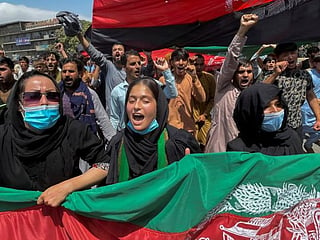America had no decent reason to stay in Afghanistan
War in Afghanistan was lost to Taliban long before Biden decided to pull out all US troops

In 2019, air strikes in Afghanistan killed some 700 civilians, more than in any other year since the war’s start, according to the Costs of War Project, a group working to tally the human toll of America’s post-9/11 conflicts.
US and Nato air strikes declined in 2020 after Donald Trump’s withdrawal agreement with the Taliban, but strikes by the Afghan air force increased.
“As a consequence, the A.A.F. is harming more Afghan civilians than at any time in its history,” Neta C. Crawford, chair of the political science department at Boston University and co-director of the Costs of War Project, wrote last year.
I don’t know the name or background of any of these civilians as I know the name of Zaki Anwari, the 17-year-old member of Afghanistan’s national youth soccer team who fell to his death after clinging to a US military plane evacuating people from Kabul.
But America is as responsible for them as it is for the Afghans who will die because of our mismanaged withdrawal. Amid the wrenching scenes of the war’s denouement, that’s easy to forget, especially when commentators pretend that the conflict Joe Biden inherited could have been maintained at little price.
Critiques of Biden’s Afghan policy
There are two primary critiques of Biden’s Afghan policy. The first, which is valid, blames the administration for not clearing bureaucratic obstacles that kept Afghan allies waiting for visas, possibly stranding tens of thousands of people who deserve to be evacuated. The second, which is absurd, blames Biden for defeat in a war that was lost years ago.
Ryan Crocker, Barack Obama’s former ambassador to Afghanistan, criticised the administration’s lack of “strategic patience” in a guest essay in The New York Times. “Mr. Biden’s decision to withdraw all US forces destroyed an affordable status quo that could have lasted indefinitely at a minimum cost in blood and treasure,” he wrote.
In The Washington Post, Condoleezza Rice wrote, “We — and they (Taliban) — needed more time.”
The argument for “patience” or “more time” assumes that the American presence in Afghanistan was doing more good than harm. For some Afghans, particularly in the capital, this was undoubtedly true. Keeping a contingent of US troops in Afghanistan might well have protected those who will be most hurt by Taliban.
But for America to remain in Afghanistan, Biden would have had to renege on Trump’s deal with the Taliban. More US troops would be required, and fighting, including US air strikes, would almost certainly ramp up. That would mean more suffering, and more death, for many Afghan civilians.
Crawford told me that the United Nations Assistance Mission in Afghanistan began releasing data on civilian casualties in 2008. Most years, she said, the Taliban, al-Qaida and Daesh were responsible for the majority of civilian deaths, but not every year.
“What we’ve seen overall is an increase in the number of civilians who’ve been killed since 2008,” she said.
There were about 3,000 civilians killed in 2020, and before the Taliban takeover, she said, 2021 was on track to be as bad or worse.
Now, even though the Taliban has free rein, she thinks civilian deaths could decline. “Given the collapse, or the withdrawal, of the Afghan national forces, military and police, I actually think we’re not going to reach what we were on track for, because some of these areas, people won’t be contesting for land. There won’t be air strikes, which kill a lot of people. There will be less shelling.”
As the journalist Azmat Khan wrote on Twitter, “Many young people in rural battlefields have never experienced life without war, without US bombings, Taliban attacks, night raids by Afghan forces, kidnappings.” Hard as it is to understand, “some youth feel they have a shot at a future now.”
Improving the average Afghan’s life
Maybe American violence in Afghanistan could be justified if it were improving the average Afghan’s life. But often we seem to have made people’s lives harder.
The most recent report from the Special Inspector General for Afghanistan Reconstruction paints a damning picture of two decades of American efforts in Afghanistan: “US officials often empowered power brokers who preyed on the population or diverted US assistance away from its intended recipients to enrich and empower themselves and their allies.
Lack of knowledge at the local level meant projects intended to mitigate conflict often exacerbated it, and even inadvertently funded insurgents.”
Speaking of those who think Americans could have stayed in Afghanistan long-term simply to avoid losing, Crawford said, “What most of the conversation seems to be assuming here is that the level of civilian misery is taken out of the equation, and all that matters is who controls Kabul.”
Taliban control of Kabul, of course, will also inflict civilian misery, and some youth will feel they’ve lost a shot at a future. There was never a decent way to leave the country, which is why we fought a futile war for 20 years. But there also wasn’t a decent way to stay.
Michelle Goldberg is a prominent American author and political columnist
The New York Times
Sign up for the Daily Briefing
Get the latest news and updates straight to your inbox







